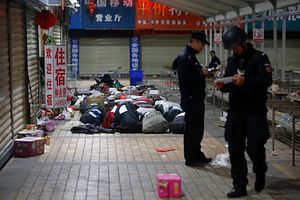The horrific knife attack that killed 29 and injured 143 at a railway station in Kunming, a city in southwestern China, on Saturday is allegedly the latest act of public violence by Uyghur separatists. Uyghurs have been blamed for dozens of attacks both within and outside of their Xinjiang autonomous region homeland for decades, including the recent Beijing Tiananmen Gate SUV incident in which five people – including the three alleged perpetrators – were killed. But this latest attack presents a paradigm shift.
Assuming the latest allegation of Uyghur involvement bears out, the Kunming massacre suggests a new phase in separatist violence. Attacks outside Xinjiang have either been blamed on or claimed by Uyghur separatists in the past, but this latest incident stands apart. Its random, indiscriminate gruesomeness, as evidenced by the bloodily graphic images circulating on Chinese social media, make it China’s most chilling textbook act of terror yet.
Unleashing their violence on an unsuspecting public at the busy Kunming Railway Station, the terrorists chose a venue with prime terror multiplier value. Far removed from the remote restive areas of Xinjiang, the Kunming attack could have happened at any train or bus station in the country. This was no target of distant, symbolic importance, but one designed to spread disproportionate fear among a national audience. Rail is the archetypal mode of transport for China’s commuting public, and like any provincial rail hub, Kunming station is ordinarily a throng of commuters, tourists and migrant workers and the stall operators and hawkers that service them. The fear message behind the choice of venue is clear: this could happen anywhere and to anyone.
That the attackers avoided detection by standard station security procedures will, no doubt, send shockwaves through China’s domestic transport systems, resulting in fierce scrutiny and tightening of measures.
Knife attacks are not uncommon in China. The illegality of handguns and lack of access to lethal weaponry means that knives, improvised explosives and fire are the weapons of choice in China for perpetrators of public violence. But despite the apparent crudeness of the weaponry used in this attack, it was coordinated and sophisticated, involving at least eight perpetrators. The bloody scenes occasioned by the ensuing mass knifing provided for maximum news media effect.
Controversy has raged over the use of the term “terrorism” to describe random acts of public violence in China. Many international commentators have criticized Beijing for being quick to use the term in relation to Uyghurs, yet avoiding the term when it comes to lone acts of public violence perpetrated by marginalized Han Chinese petitioners. In turn, Beijing has slammed Western coverage – and CNN in particular – for sympathizing with terrorists by failing to accept its characterization of Uyghur violence as terrorism. On Monday, following heavy Chinese outrage, the U.S. State Department commented that the incident “appears to be an act of terrorism targeting random members of the public.”
Opinion has also been divided within international commentary and among China’s netizens. While many foreign commentators had framed the Tiananmen SUV attack, for example, as a mere act of desperation, others acknowledged a terrorist dimension (including this piece in The Diplomat). Similarly, while many in China’s blogosphere have voiced in-principle sympathy for the plight of Han petitioners driven to acts of mass violence, many outraged netizens have branded them as terrorists. By comparison to these, however, the Kunming attack appears unambiguously to be an act of terror.
The perpetrators of this incident have produced a spectacle of terrorist asymmetry. As political leaders converge upon Beijing for the opening of the National People’s Congress (NPC) and Chinese People’s Consultative Conference (CPCC) meetings, they do so in the knowledge that more than rhetoric will be needed to contain the fallout from this incident. While on the one hand the incident will give the leadership a clear mandate to strike harder than ever against separatist elements, it has also exposed the failure of existing measures. And authorities have a real fight on their hands if recent events have the effect of further emboldening domestic terrorists.
Not so long ago, such violence rarely rated a mention in media outside of China. With the Tiananmen Gate incident and now Kunming, Uyghur-linked public violence is now making international prime-time news, and social media within China is delivering news and opinion to mobile devices across the country. Rage has predictably lit up China’s micro-blogoshpere. Chinese commuters are most unlikely to develop sympathies towards the Uyghur plight as a result, but they will now no doubt fear for their own safety in a way that they never have before.
Whether or not Uyghurs are actually behind these attacks, whether or not they are jihadists or motivated by local issues, and whether or not the attacks constitute acts of “terror” may not ultimately matter so much to Beijing if it is unable to curb such violence and provide for its citizens the security they demand.
Nicholas Dynon is a PhD candidate at Macquarie University and is coordinator of the Line 21 project.

































